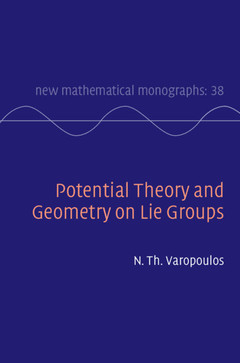Description
Potential Theory and Geometry on Lie Groups
New Mathematical Monographs Series
Author: Varopoulos N. Th.
Complete account of a new classification of connected Lie groups in two classes, including open problems to motivate further study.
Language: English
Subject for Potential Theory and Geometry on Lie Groups:
Publication date: 10-2020
611 p. · 23.5x16 cm · Hardback
611 p. · 23.5x16 cm · Hardback
Description
/li>Contents
/li>Biography
/li>
This book provides a complete and reasonably self-contained account of a new classification of connected Lie groups into two classes. The first part describes the use of tools from potential theory to establish the classification and to show that the analytic and algebraic approaches to the classification are equivalent. Part II covers geometric theory of the same classification and a proof that it is equivalent to the algebraic approach. Part III is a new approach to the geometric classification that requires more advanced geometric technology, namely homotopy, homology and the theory of currents. Using these methods, a more direct, but also more sophisticated, approach to the equivalence of the geometric and algebraic classification is made. Background material is introduced gradually to familiarise readers with ideas from areas such as Lie groups, differential topology and probability, in particular, random walks on groups. Numerous open problems inspire students to explore further.
Preface; 1. Introduction; Part I. The Analytic and Algebraic Classification: 2. The classification and the first main theorem; 3. NC-groups; 4. The B–NB classification; 5. NB-groups; 6. Other classes of locally compact groups; Appendix A. Semisimple groups and the Iwasawa decomposition; Appendix B. The characterisation of NB-algebras; Appendix C. The structure of NB-groups; Appendix D. Invariant differential operators and their diffusion kernels; Appendix E. Additional results. Alternative proofs and prospects; Part II. The Geometric Theory: 7. The geometric theory. An introduction; 8. The geometric NC-theorem; 9. Algebra and geometries on C-groups; 10. The end game in the C-theorem; 11. The metric classification; Appendix F. Retracts on general NB-groups (not necessarily simply connected); Part III. Homology Theory: 12. The homotopy and homology classification of connected Lie groups; 13. The polynomial homology for simply connected soluble groups; 14. Cohomology on Lie groups; Appendix G. Discrete groups; Epilogue; References; Index.
N. Th. Varopoulos was for many years a professor at Université de Paris VI. He is a member of the Institut Universitaire de France.
© 2024 LAVOISIER S.A.S.

